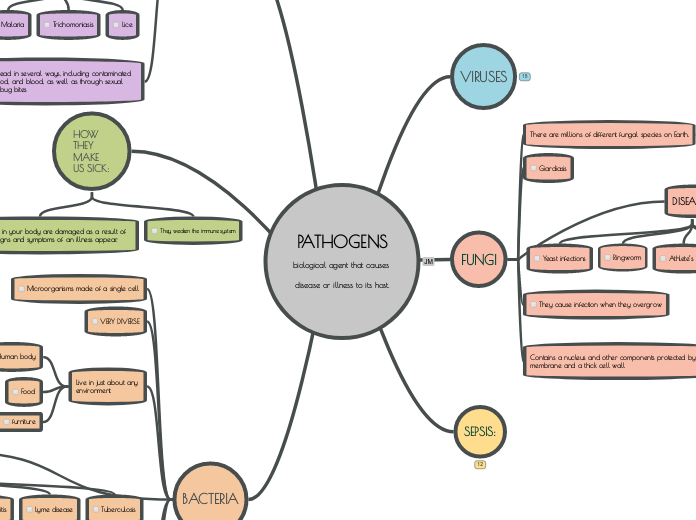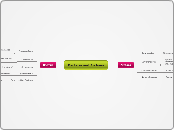PATHOGENS
biological agent that causes disease or illness to its host.
BACTERIA
There are thousands of species, but only one hundred cause infection and diseases
Some bacteria is good for our body, while some are very hurtful causing infection and disease
Bad bacteria=pathogenic bacteria
Antibiotics are used to treat bacterial infections. Sometimes bacteria becomes resistant, making it difficult to treat.
Your body can becomes prone to bacterial infections when your immune system is compromised. The disease state enables harmless bacteria to become pathogenic
Most of the time bacteria isn't causing diseases - but the toxins that are produced by the bacteria
Tuberculosis
Lyme disease
Bacterial meningitis
Strep throat
Pneumonia
Staphylococcal infections
Live in just about any environment
furniture
Food
Human body
VERY DIVERSE
Microorganisms made of a single cell
HOW THEY MAKE US SICK:
They weaken the immune system
when the cells in your body are damaged as a result of infection and signs and symptoms of an illness appear.
PARASITES
They are spread in several ways, including contaminated soil, water, food, and blood, as well as through sexual contact and bug bites
Lice
Trichomoniasis
Malaria
Parasites are organisms that behave like tiny animals, living in or on a host and feeding from or at the expense of the host
Parasitic infections are more common in tropical and subtropical regions, but they can occur anywhere.
ECTOPARASITE: which are multi-celled organisms that live on or feed off your skin, including some insects, such as ticks and mosquitos
HELIMITHS: which are larger, multi-celled organisms that can live inside or outside your body and are commonly known as worms
PROTOZOA: which are single-celled organisms that can live and multiply in your body
SEPSIS:
Early treatment of sepsis, usually with antibiotics and large amounts of intravenous fluids, improves chances for survival
If sepsis progresses and gets worse, this may lead to septic shock, causing blood pressure drops dramatically, leading to organ faliure and potentially death
SEPTIC SHOCK:
Septic shock is a life-threatening condition that happens when your blood pressure drops to a dangerously low level after an infection.
To be diagnosed with septic shock, you must have a probable or confirmed infection and both of the following:
High levels of lactic acid in your blood after you have received adequate fluid replacement.
The need for medication to maintain blood pressure greater than or equal to 65 millimeters of mercury (mm Hg).
Sepsis is a potentially life-threatening condition caused by the body's response to an infection. The body normally releases chemicals into the bloodstream to fight an infection. Sepsis occurs when the body's response to these chemicals is out of balance, triggering changes that can damage multiple organ systems
ASEPSIS:
Directed toward maintaining cleanliness and eliminating contamination.
using techniques such as proper handwashing, good personal hygiene, use of disposable gloves, proper cleaning of instruments and equipment, and thorough cleaning of the environment.
The absence of disease-producing microorganisms, or pathogens
FUNGI
Contains a nucleus and other components protected by a membrane and a thick cell wall
Some new strains of fungal infections are proving to be especially dangerous
Their structure can make them harder to kill
They cause infection when they overgrow
Fungal nail infections
Jock itch
Athlete’s foot
Ringworm
Yeast infections
Giardiasis
There are millions of different fungal species on Earth.
They are primitive plants that inhabit our environment
VIRUSES
Viral diseases are hard to treat because many can withstand heat, chemicals, and large doses of radiation
Over 150 viruses known to cause disease in humans
CAN NOT be treated my antibiotics
DISEASES:
HIV & AIDS
Chicken pox/shingles
Warts
Meningitis
Flu
Common cold









